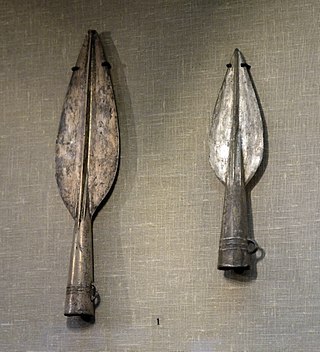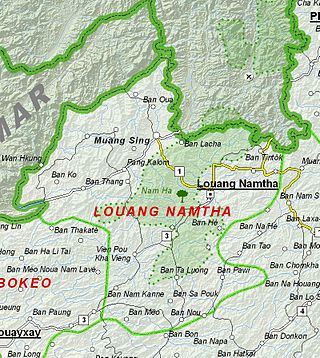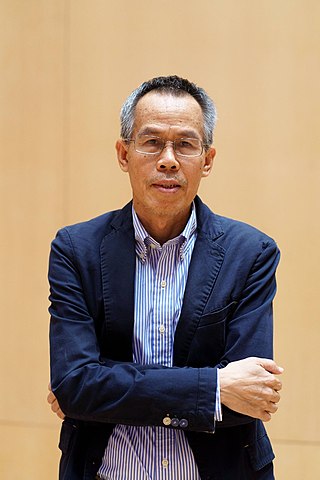
The Bronze Age is a historic period, lasting approximately from 3300 BC to 1200 BC, characterized by the use of bronze, the presence of writing in some areas, and other early features of urban civilization. The Bronze Age is the second principal period of the three-age system proposed in 1836 by Christian Jürgensen Thomsen for classifying and studying ancient societies and history. It is also considered the second phase, of three, in the Metal Ages.

Evidence for modern human presence in the northern and central highlands of Indochina, that constitute the territories of the modern Laotian nation-state dates back to the Lower Paleolithic. These earliest human migrants are Australo-Melanesians—associated with the Hoabinhian culture—and have populated the highlands and the interior, less accessible regions of Laos and all of South-east Asia to this day. The subsequent Austroasiatic and Austronesian marine migration waves affected landlocked Laos only marginally and direct Chinese and Indian cultural contact had a greater impact on the country.

The Khorat Plateau is a plateau in the northeastern Thai region of Isan. The plateau forms a natural region, named after the short form of Nakhon Ratchasima, a historical barrier controlling access to and from the area.

Ban Chiang is an archaeological site in Nong Han district, Udon Thani province, Thailand. It has been a UNESCO World Heritage Site since 1992. Discovered in 1966, the site first attracted interest due to its ancient red-painted pottery. More recently, it gained international attention in 2008 when the United States Department of Justice, following an undercover investigation begun in 2003, raided several museums for their role in trafficking in Ban Chiang antiquities.

Penn Museum, formerly known as The University of Pennsylvania Museum of Archaeology and Anthropology, is an archaeology and anthropology museum at the University of Pennsylvania. It is located on Penn's campus in the University City neighborhood of Philadelphia, at the intersection of 33rd and South Streets. It also is close enough for Drexel University students to walk or take Septa transportation services. Housing over 1.3 million artifacts, the museum features one of the most comprehensive collections of middle and near-eastern art in the world.

The history of Isan has been determined by its geography, situated as it is on the Korat Plateau between Cambodia, Laos, and Thailand.
Hoabinhian is a lithic techno-complex of archaeological sites associated with assemblages in Southeast Asia from late Pleistocene to Holocene, dated to c. 10,000–2000 BCE. It is attributed to hunter-gatherer societies of the region and their technological variability over time is poorly understood. In 2016 a rockshelter was identified in Yunnan (China), where artifacts belonging to the Hoabinhian technocomplex were recognized. These artifacts date from 41,500 BCE.

Ban Non Wat is a village in Thailand, in the Non Sung district, Nakhon Ratchasima Province, located near the small city of Phimai. It has been the subject of excavation since 2002. The cultural sequence encompasses 11 prehistoric phases, which include 640 burials. The site is associated with consistent occupation, and in modern-day Ban Non Wat the occupied village is located closer to the Mun River.

Charles Franklin Wandesforde Higham is a British-born New Zealand archaeologist most noted for his work in Southeast Asia. Among his noted contributions to archaeology are his work about the Angkor civilization in Cambodia, and his current work in Northeast Thailand. He is an emeritus professor at the University of Otago in Dunedin.
Chester F. Gorman was an American anthropologist and archaeologist.

Prehistoric Thailand may be traced back as far as 1,000,000 years ago from the fossils and stone tools found in northern and western Thailand. At an archaeological site in Lampang, northern Thailand Homo erectus fossils, Lampang Man, dating back 1,000,000 – 500,000 years, have been discovered. Stone tools have been widely found in Kanchanaburi, Ubon Ratchathani, Nakhon Si Thammarat, and Lopburi. Prehistoric cave paintings have also been found in these regions, dating back 10,000 years.

The Seima-Turbino phenomenon is a pattern of burial sites with similar bronze artifacts dated to c. 2300–1700 BCE found across northern Eurasia, particularly Siberia and Central Asia, maybe from Fennoscandia to Mongolia, Northeast China, Russian Far East, Korea, and Japan. The homeland is considered to be the Altai Mountains. These findings have suggested a common point of cultural origin, possession of advanced metal working technology, and unexplained rapid migration. The buried were nomadic warriors and metal-workers, traveling on horseback or two-wheeled carts.

Bolikhamsai is a province of Laos. Pakxan, Thaphabat, Pakkading, Borikhane, Viengthong, and Khamkeut are its districts and Pakxan is its capital city. The province is the site of the Nam Theun 2 Dam, the country's largest hydroelectric project.

Savannakhet is a province of Laos. The name derives from Savanh Nakhone the province's original name. It bears the same meaning as Nakhon Sawan, a city in Thailand.

Luang Namtha is a province of Laos in the country's north. From 1966 to 1976 it formed, together with Bokeo, the province of Houakhong. Luang Namtha province covers an area of 9,325 square kilometres (3,600 sq mi). Its provincial capital is Luang Namtha. The province borders Yunnan, China to the north, Oudomxai province to the east and southeast, Bokeo province to the southwest, and Shan State, Myanmar to the northwest.

Ban Kao is a tambon (sub-district) of Mueang Kanchanaburi District, in Kanchanaburi Province, Thailand. In 2017, it had a population of 16,147 people. The tambon contains 15 villages. This network of villages had its origins in northern China and this is reinforced by pottery and ceramic fragments. The pottery and ceramic fragments found at Ban Kao highlight it's archaeological significance in Southeast Asia; some of these fragments are currently being kept at the Ban Kao National Museum.
Miriam T. Stark is an American archaeologist whose field experience and emphasis of studies have included locations in North America, the Near East and Southeast Asia. She is currently a professor of Southeast Asian Archaeology at the University of Hawai’i-Manoa, a position she has held since August 1995. Having first received her B.A. from the University of Michigan, she went on to complete her M.A and PhD from the University of Arizona. Stark has co-directed the Lower Mekong Archaeological Project (LOMAP), located in southern Cambodia for the past 12 years. Her research focus not only includes the various aspects of political economy, but also on the process of state formation.

Ban Sop Ruak is a village in Wiang subdistrict (tambon) of Chiang Saen District (amphoe) in Chiang Rai Province, northern Thailand. The village is situated at the confluence of the Ruak River and the Mekong River which forms the tripoint border of Thailand, Myanmar and Laos. This location has enabled it to be marketed to tourists as the "heart" of the Golden Triangle, as the area is popularly known as.

Thanik Lertcharnrit is a Thai Archeologist and Anthropologist and Professor at Silpakorn University. He specializes in southeast Asian archaeology and the public education and perception of archeology, with a focus on public Thai cultural heritage. Professor Lertcharnrit has made many contributions to the field of Cultural Resource Management (CRM), and acted as a pioneering figure and advocate for global public archaeology.
Operation Antiquity is one of a series of operations by U.S. federal law enforcement agencies to investigate the smuggling of ancient artifacts from Thailand to the United States since 2002. After several years of secrecy, the case was uncovered on January 24, 2008 by federal law enforcement officers who raided multiple museums, shops, warehouses, and the homes of private art collectors and made headlines in several international media at the time. news.



















